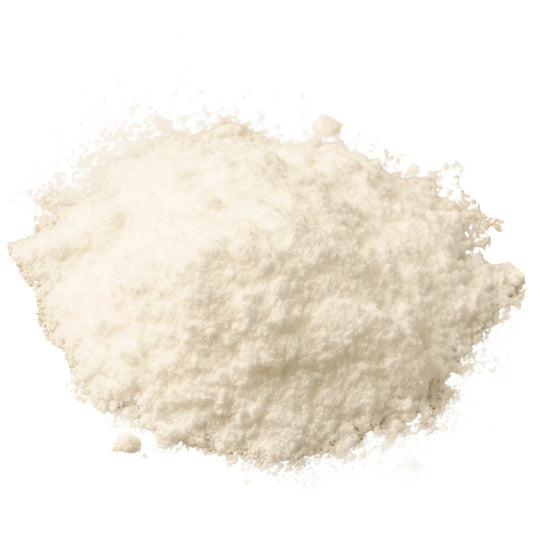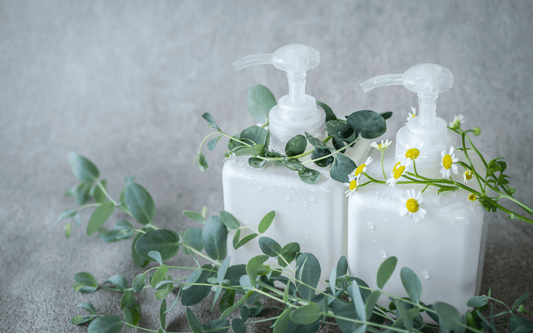
Easy Oil Based Serums
Juliette van der MeerA few weeks ago we shared Easy Water Based Serums which you all loved, so we thought we'd continue the theme, this time with oils. Oil based serums contain one or more carrier oils and can also include some oil-soluble actives to really bump up their efficacy. Oil based serums will obviously have an oily feel to them, but still sink into the skin and are wonderfully nourishing and moisturising.
What Can You Add To An Oil Serum?
Oil serums consist of high performance oils and oil-soluble actives like Vitamin A, Co Enzyme Q10, bisabolol, etc. The primary ingredients in oil serums will be the carrier/plant oils you use. Now, there are quite a lot of carrier oils to choose from, so to help you decide which ones to use, we've compiled some info on our favourites, as well as a few for specific skin conditions.
Carrier Oils for Dry Skin
Strangely but fittingly, oils from plants that grow in dry environments are good for dry skin: think argan, jojoba, kalahari melon, prickly pear, etc. So if you are prone to dry skin, try including one of more of these oils in your serum.
Carrier Oils for Mature Skin
For mature skin there are a couple of fantastic options: avocado oil contains omega 7 (which, like collagen, slows production as we age), and is ultra nourishing; pomegranate oil is renowned for its anti aging benefits. Various other oils for mature skin are discussed below in the oils glossary section. You'll notice that these oils are all on the thicker, slower absorbing side, providing additional moisturising benefits and nutrition to the skin.
Carrier Oils for Outdoor Skin
Outdoor skin: red raspberry contains large amounts of antioxidants, tocopherols and phytosterols to help combat environmental damage.
Carrier Oils for Troubled Skin
Troubled skin: hemp seed oil contains compounds to repair the skin, and helps improve skin barrier function; tamanu oil has a reputation for being a healing oil.
Non - Greasy Carrier Oils
Dry feel and non greasy oils: camellia (can halt overproduction of oil in the skin), hazelnut, almond, macadamia, baobab, squalane and hemisqualane are all considered easily absorbed with a drier skin feel. It's nice to include a dry oil into an oil serum where you want a quicker absorbency rate and less greasy feel.
- A good resource to read up more on carrier oils: Quick Guide To Carrier Oils & Butters
Carrier Oils Glossary
We could go on for pages, but here is a run through of our favourite oils to use in oil serums:
This famous oil from Morocco is rich in oleic and linoleic acid, Vitamin E, antioxidants and phenols. It can slow the signs of aging by reducing oxidative stress, increasing hydration and increasing elasticity. It is ultra moisturising and can treat skin conditions and dryness, as well as promote wound healing. A light but penetrating oil, a little argan oil goes a long way.
Baobab oil is much loved in African skincare for its rich Omegas 3, 6 & 9 and vitamins A, D, E, and F content. It is a very light but deeply restorative oil, helping with blemishes, sun damage, improving skin condition, reducing wrinkles and scars and justy being an all rounder.
Calendula is an infused oil, rather than a pressed oil, and it is infused with the gorgeous calendula flower along with its benefits. It is considered healing, and great for problem skin and dry skin.
Carrot oil is rich in provitamin A, and is great for dry and wrinkled skin, and for protecting against environmental damage.
Coffee oil has the rich roasted scent of freshly brewed coffee that will make you fall in love with it! Besides its amazing aroma, coffee oil is also rich in fatty acids and is stimulating on the skin, increasing blood flow for a younger and smoother complexion.
With a deliciously light, summery cucumber fragrance, cucumber seed oil is light, easily absorbed and highly moisturising.
Jojoba oil is actually not an oil but a liquid wax, and its composition is very similar to that of our skins, making it particularly loved in skincare. It is great for all skin types and absorbs well.
Rich in Vitamins E and C and antioxidants, marula oil is known for its regenerating, repairing and rehydrating nature. It is a beautifying oil and imparts a lovely glow to the skin.
A light oil, easily absorbed and rich in Vitamin E and fatty acids.
The oil of 'the divine fruit' is a speciality oil with high performance in the skincare department. It is rich in antioxidants, polyphenols and Vitamin C. It encourages cell repair and regeneration, reducing the appearance of wrinkles, damaged and problem skin.
Prickly pear is one of the more costly carrier oils, and is prized for its intensely moisturising properties, as well as its high Vitamin E, antioxidant, linoleic, oleic and palmitic acids content. It can help brighten skin, get rid of dark marks, reduce wrinkles and add firmness to the skin. It is great for all skin types but is particularly good for dry and mature skins.
Rice bran oil is extremely rich in Vitamin E, and is particularly good for mature and dry skins. It is fast absorbing.
Rich in omega acids and gamma linolenic acid, evening primrose oil is wonderful for treating problem skin, dryness and sensitivity, and aging skin. It promotes elasticity, even texture and a softer, more youthful look.
Red raspberry seed oil offers the anti-aging benefits of softening wrinkles and fine lines, improving elasticity and suppleness and being rich in antioxidants, ellegic acid, Vitamins E and A, and alpha linoleic acid. It contains antioxidants and phytosterols which help repair skin damage.
Bring back your skin's natural glow with rosehip oil. Packed with vitamins and healthy acids, rosehip is able to deeply moisturise skin and reduce the signs of aging and pigmentation, brighten and even out skin tone, help fade scars and even firm up your skin.
Vividly orange in colour, seabuckthorn berry oil is a speciality oil rich in beta carotene and Omega 7. The oil is harvested from the sea buckthorn shrub of the Himalayas and contains many vitamins, minerals and beneficial compounds that help protect against aging and sun damage, and promote cell regeneration and elasticity. You only need a few small drops of this potent oil to get all the benefits. Max usage 5%. If you use too much of this oil it may stain.
Popular in cosmetics and the beauty world, squalane is an emollient that seals in moisture and minimizes moisture loss. Apply it after you apply your hyaluronic acid at night to seal in the moisture, and wake up with dewy, glowing skin. It is ultra lightweight and a non greasy, non comedogenic oil derived from sustainably sourced sugarcane.
Primarily a healing oil, tamanu oil is perfect for helping restore problem skin to its healthy best. It is rich in anti inflammatory properties, antioxidants, Vitamin E and fatty acids. It is good for scarring, abrasions, eczema and acne, rashes and just about any other problem skin condition.
Actives
Bisabolol is a wonderful anti-irritant, anti inflammatory and skin protectant. It is anti aging, stimulates the skin's renewal process, improves damaged skin and can protect against the daily environmental stresses that our skin faces. Typical usage is 0.1-1%
CoQ10 is naturally present in the skin but decreases with age. It helps increase anti oxidant protection in the skin, preventing oxidative damage. Typical usage is 1-3%
Typical usage is around 0.1 -0.5%. It is said to help improve skin penetration and I love using it at low amounts in my cream moisturisers. Lecithin is a brown and sticky substance so don't go overboard with this one or your serum will also start to get brown and sticky too. Stick to the very small amounts recommended.
Vitamin A palmitate is a form of Vitamin A and is part of the retinoid family. It promotes skin cell turnover, improves skin tone, unclogs pores, stimulates collagen production, counteracts the appearance of dry flaky skin. Typical usage is 0.5%
A potent antioxidant and skin protectant, Vitamin E is a great addition to any oil serum. Typical usage is 0.5%
Although I personally don't really bother with extensive use of essential oils in my serums (I prefer fragrance free products), you can definitely include them in your creations if you like! Depending on the essential oil used, I would stick to around 0.2-0.5% total usage, and I would avoid essential oils like cinnamon, wintergreen, camphor, certain citrus oils and other potentially sensitizing and overpowering oils. Your facial skin is more sensitive than other areas so you need to be mindful of this when designing your serums. Other than these cautions, go wild!
You can use butters in oil serums to help give a little more viscosity, and reap the benefits of skin butters.
Infusing your oils with botanicals is a wonderful way to include more benefits in your serum. You can research the components of various botanicals and find out if they are oil soluble or water soluble (Google is your friend here). If they are oil soluble, go ahead with your oil maceration to infuse them into your oil!
How to colour your oil serum
For shades of pink and red: infuse oils with rose petals, hibiscus
For yellow: Co enzyme Q10
For orange: sea buckthorn berry oil
For pale blue/turquoise: chamomile blue/German chamomile (your oils will need to be neutral coloured in order for this to show through)
For green: infuse with spirulina
What You Can't Use In An Oil Serum
Being an oil based product, you can't use water based ingredients and actives in an oil serum because the two don't mix together. This means you can't use glycerine, hyaluronic acid, aloe vera gel, water-soluble actives like niacinamide and Vitamin C, hydrosols, allantoin or any other water based or soluble ingredients. You need to stick to oils and oil soluble ingredients.
Do You Need A Preservative In An Oil Serum?
Since oil serums contain no bacteria-loving water, the good news is that you don't need to add a preservative. I like to add Vitamin E for its excellent skin properties as well as its antioxidant properties, but that is all (and Vit E is not classed as a preservative, it is only an antioxidant).
A guide to combining oils
Firstly, there's no right or wrong way to combine oils, and apart from the few usage recommendations mentioned above, there is no set usage amount that you need to adhere to when it comes to carrier oils.
It comes down to the type of skin you are making the serum for, and what oils will be most effective. Look over the oils and their properties above to decide on a handful you would like to use together. Then think about adding any essential oils and actives, if appropriate.
Recipes
African Radiance Serum
I am rather partial to oils of African origin because I like supporting local farmers, and I find that African oils are well suited to skins that dwell under the African sun. We have hot and sometimes drying seasons and oils that come from plants that grow in dry conditions are great for dry skins. It's like plants know!
Ingredients:
- 20% baobab
- 15% prickly pear
- 20% marula
- 44% squalane
- 0.5% Vitamin E
- Optional: 0.5% essential oil of choice. Some nice ones might be helichrysum or geranium, in keeping with the African theme.
Method: Weigh out the oils and blend them all together in a pipette bottle.
To use, apply after cleansing your skin. You can apply on top of water based serums.


















